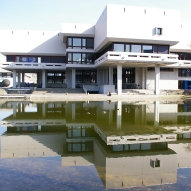Zusammenfassung
Objective: Osteoarthritis (OA) pathogenesis involves the interaction of articular cartilage with surrounding tissues, which are innervated by tyrosine hydroxylase-positive (TH+) sympathetic nerve fibers suggesting a role of the sympathetic nervous system (SNS) during OA progression. We analyzed the effects of sympathectomy (Syx) in a murine OA model. Methods: Peripheral Syx was generated by ...
Zusammenfassung
Objective: Osteoarthritis (OA) pathogenesis involves the interaction of articular cartilage with surrounding tissues, which are innervated by tyrosine hydroxylase-positive (TH+) sympathetic nerve fibers suggesting a role of the sympathetic nervous system (SNS) during OA progression. We analyzed the effects of sympathectomy (Syx) in a murine OA model. Methods: Peripheral Syx was generated by 6-hydroxydopamine (6-OHDA) injections in male C57BL/6 mice. OA was induced in wild-type (WT) and Syx mice by destabilization of the medial meniscus (DMM). TH+ fibers and splenic NE were analyzed to evaluate Syx efficiency. OA progression was examined by OARSI and synovitis scores and micro-CT. Expression of TH, alpha 2A- and beta 2-adrenergic receptors (AR), and activity of osteoblasts (ALP) and osteoclasts (TRAP) was investigated by stainings. Results: Syx resulted in synovial TH+ fiber elimination and splenic NE decrease. Cartilage degradation and synovitis after DMM were comparably progressive in both WT and Syx mice. Calcified cartilage (CC) and subchondral bone plate (SCBP) thickness and bone volume fraction (BV/TV) increased in Syx mice due to increased ALP and decreased TRAP activities compared to WT 8 weeks after DMMWT and Syx mice developed osteophytes and meniscal ossicles without any differences between the groups. AR numbers decreased in cartilage but increased in synovium and osteophyte regions after DMM in bothWT and Syx mice. Conclusion: Peripheral dampening of SNS activity aggravated OA-specific cartilage calcification and subchondral bone thickening but did not influence cartilage degradation and synovitis. Therefore, SNS might be an attractive target for the development of novel therapeutic strategies for pathologies of the subchondral bone. (C) 2021 Osteoarthritis Research Society International. Published by Elsevier Ltd. All rights reserved.






 Altmetric
Altmetric